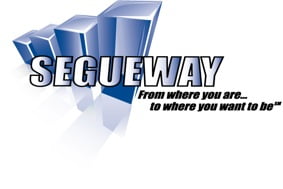Segueway to Success
Listen at – “Factoring as a Segueway to Success”
Previous Archived Shows – On Demand – “Segueway to Success” talk radio podcast
By: Brent Hamachek and Tom Kuchan
Our “Segueway to Success” show, talking about our blog, airs each Wednesday at 15:00 CST. Find this week’s show and the archives on our web site: www.seguewaysolutions.com/Articles-and-Events.html
The recession, which began in 2007, has changed the landscape of business financing. Over the past few months, Segueway to Success has featured numerous guests from various sectors of the world of business finance. This week we tackle the growing, and often-misunderstood world of factoring.
There is evidence that over 4,000 years ago the Mesopotamians began the practice of factoring. The Roman Empire also had it as a common practice. In the United States, factoring finds its origin in England during the 14th through 17th centuries and the burgeoning period of world exploration and trade. Factoring is indeed as old and as practiced as is another famous human profession with a more colorful but no less tarnished image.
Factoring is actually very basic and simply involves the purchasing of an invoice from a business customer, on a discounted basis, to provide the business with immediate liquidity and to speed up its cash cycle. The factor provides a vital service to the business sector, so why does factoring enjoy a less than favorable reputation?
In part, it is a function of not understanding what factors do, how they work, and when a company is an appropriate candidate for their use. Another reason is that since they are used for business financing they are incorrectly compared to commercial banks who provide traditional account receivable financing at a lower interest rate. As banks are adverse to significant credit risk they are not typically competing for the same client as the factor who advances funds to businesses with a riskier credit profile – at least until this recession started they were not direct competitors but that has changed a bit. Finally, the idea of selling your assets for a high price to someone else to own has been glorified as the transaction between mobster and shop owner in American history, film and folklore. People tend to reflexively think of factors as gangsters.
The truth, as is often the case, is actually quite different. Factoring is necessary to make the economy run and provide “non-bankable” businesses with a way to fund their cash needs and become bankable again. When a company has faced prior period losses, or is in an industry which experiences a downturn causing banks to exit, like construction, the factor can be the only solution for survival and recovery.
Rates vary but can run from 18 percent to the mid-30 percent range depending upon the industry and the client’s circumstances. Advance rates can be as low as 50% and as high as 80-85%, again, depending upon the same conditions.
At one time, factoring carried a dark stained stigma, like a scarlet letter. In recent years that has changed as so many companies were damaged by the recession and the banking industry responded by retreating like a French soldier, that businesses everywhere are used to seeing their vendor present them with a new factoring relationship. The stigma, while not gone, has faded.
How and when to factor, and the advantages and disadvantages, need to be understood by the erstwhile business factoring prospect. Because of the rigidity of banking today, companies with profit margins that can tolerate a factor’s rate may wish to factor even if they are bankable just to avoid the capriciousness of the bank’s loan committee changing their borrowing terms midstream. Because factoring has traditionally been thought of as “something that sick companies do”, a business may pass on an opportunity that could provide significant benefit and facilitate rapid growth.
Join us on Segueway to Success this week when our guest will be Debra Wilson from Vertex Financial in Dallas, Texas. Debra has been in the factoring industry for over 30 years and has watched it pass through various phases and client perceptions. She will make a foreign topic feel domestic and perhaps enlighten one of our listeners enough to at least consider the unthinkable; factoring their assets as a choice, not as a necessity or last ditch effort.
Segueway Solutions – http://www.seguewaysolutions.com/
+1 (847) 778-9474
Brent E. Hamachek spent the first 15 years of his professional life in banking, working in 6 different sectors including audit, credit and 9 years as a commercial banker.
After commercial banking, Brent formed Segueway Solutions in 2000 in order to assist privately held companies in transition. To date, he has worked in 40 different industries and has served in the capacity of CEO, CFO & EVP Sales for clients. Brent is a sought after consultant, speaker and trainer offering national and foreign expertise to clients.
brent@SeguewaySolutions.com
Tom Kuchan is a proven leader in global business expansion and effectiveness, risk management, finance and operations with experience in both Fortune 50 and entrepreneurial environments. He has a proven record of defining strategic objectives, translating them into operational tasks, and leading their implementation in diverse geographies and cultures across the globe.
Tom has lived overseas for over twenty years, including Switzerland, Germany and the United Arab Emirates, and has worked extensively across Europe, Latin America, Africa, the Middle East, and Asia.
tom@SeguewaySolutions.com

